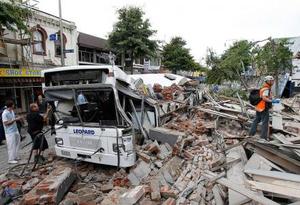DisastersLarge, magnitude 8 earthquakes hit New Zealand with regularity
A new study finds that very large earthquakes have been occurring relatively regularly on the Alpine Fault along the southwest coastline of New Zealand for at least 8,000 years

Debris of the 2011 6.3 magnitude Christchurch temblar // Source: hudong.com
A new study published in the prestigious journal Science, co-authored by University of Nevada, Reno’s Glenn Biasi and colleagues at GNS Science in New Zealand, finds that very large earthquakes have been occurring relatively regularly on the Alpine Fault along the southwest coastline of New Zealand for at least 8,000 years.
The Alpine Fault is the most hazardous fault on the South Island of New Zealand, and about eighty miles northwest of the South Island’s main city of Christchurch.
A University of Nevada, Reno release reports that the team developed evidence for twenty-two earthquakes at the Hokuri Creek site, which, with two additional from nearby, led to the longest continuous earthquake record in the world for a major plate boundary fault. The team established that the Alpine Fault causes, on average, earthquakes of around a magnitude 8 every 330 years. Previous data put the intervals at about 485 years.
Relative motion of Australian and Pacific plates across the Alpine Fault averages almost an inch per year. This motion builds up, and then is released suddenly in large earthquakes. The 530-mile-long fault is among the longest, straightest and fastest moving plate boundary faults in the world. More than 23 feet of potential slip has accumulated in the 295 years since the most recent event in A.D. 1717.
Biasi, working with the GNS Science team led by Kelvin Berryman, used paleoseismology to extend the known seismic record from 1000 years ago to 8,000 years ago. They estimated earthquake dates by combining radiocarbon dating leaves, small twigs and marsh plants with geologic and other field techniques.
“Our study sheds new light on the frequency and size of earthquakes on the Alpine Fault.
Earthquakes have been relatively periodic, suggesting that this may be a more general property of simple plate boundary faults worldwide,” Biasi, of the Nevada Seismological Laboratory said. “By comparison, large earthquakes on California’s San Andreas Fault have been less regular in size and timing.”
“Knowing the average rate of earthquakes is useful, but is only part of the seismic hazard equation,” he said. “If they are random in time, then the hazard does not depend on how long it has been since the most recent event. Alpine Fault earthquakes are more regular in their timing, allowing us to use the time since the last earthquake to adjust the hazard estimate. We estimate the 50-year probability of a large Alpine fault earthquake to be about 27 percent.”
The release notes that a magnitude 7.1 earthquake centered near Christchurch, the largest city in the South Island of New Zealand, caused extensive damage to buildings on 2 September 2010, and no deaths. On 22 February 2011, a triggered aftershock measuring magnitude 6.3, with one of the strongest ground motions ever recorded worldwide in an urban area, struck the city killing 185 people.
Among other seismic work, Biasi has conducted research on earthquake recurrence on the San Andreas Fault and is a contributor to the Uniform California Earthquake Rupture Forecast-3 project, which is developing earthquake probabilities for the California Earthquake Authority. He is a research associate professor in the College of Science’s Mackay School of Earth Sciences and Engineering.
— Read more in Kelvin R. Berryman et al, “Major Earthquakes Occur Regularly on an Isolated Plate Boundary Fault,” Science 336, no. 608929 (29 June 2012): 1690-93 (DOI: 10.1126/science.1218959)
